Qingming, literally (字面上) means “clear and bright”. It is one of the 24 seasonal division points in China. After the festival, the temperature rises and rainfall increases. And then farmers begin to grow crops. Qingming Festival falls on April 4 this year.
As a festival, Qingming is believed to have a history of about 2,500 years. The most important tradition of Qingming is to honor ancestors and remember the dead family members. So Qingming is also called Tomb-Sweeping Day. When sweeping the graves, people pray, clean the tombstones and burn offerings, usually paper money, paper clothes, paper houses and now even a paper phone.
Lots of ancient poets expressed their sad feelings with words. One of the most famous poems describing the festival was the poem Qingming by Du Mu of the Tang Dynasty as follows: A drizzling rain falls like tears on the Mourning Day; The mourner’s heart is going to break on his way. “Where can a wine shop be found to drown my sad hours?” A cowherd points to a cot amid apricot flowers.
Some traditions of Qingming have brought such problems as traffic jams and air pollution or even forest fires. As part of a greener Qingming campaign, people have been encouraged to pay respect to their ancestors and dead family members online, or burn less or no paper money to protect the environment.
1. The weather will _______ after Qingming.| A.be much warmer | B.rain heavily | C.be snowy | D.be windy |
| A.On April 1. | B.On April 2. | C.On April 3. | D.On April 4. |
| A.things for children | B.things for the poor | C.gifts for the dead | D.gifts for the old |
| A.The life of Du Mu. | B.Poems about the festival. |
| C.Poets in Tang Dynasty. | D.Sad feelings of people. |
| A.at home | B.in the open air | C.on the Internet | D.by the forests |
相似题推荐
【推荐1】“The red walls and green tiles (瓦) set each other off beautifully. It’s so Beijing,” said a 33-year-old Beijing person with the family name of Lin. Lin and her 14-year-old cousin were enjoying a city walk along the Beijing Central Axis (中轴线). On this walk, they saw most of the old city buildings of Beijing, like the Forbidden City and the Bell and Drum Towers.
Since the show “Glory Is Back! Beijing (《登场了!北京中轴线》)” was shown in July, more and more people have become interested in the Central Axis. Some even travel on foot to know it better themselves.
Dating back to the Yuan Dynasty (1271-1368), the 7.8-kilometer-long Beijing Central Axis joined royal (皇家) palaces and marketplaces for common people in the past. Though time changes many things, the Central Axis has left a special feeling with many Chinese people.
Chinese professor Lyu Zhou said that when he walked around the Bell and Drum Towers, he could find peace in the busy city life. At a square between the Bell Tower and the Drum Towers, you can see people relaxing, cycling and playing games and even celebrating life events.
“This was one of our meeting places when we went on dates (约会). You could say that the towers have seen our love grow,” said a young couple who were taking wedding photos under the Bell and Drum Towers.
A number of visitors from other parts of the world have been amazed by the Beijing Central Axis, too. The traveler Marco Polo (1254-1324), for example, wrote about what he saw along the Central Axis back in the Yuan Dynasty in The Travels of Marco Polo: “Up and down the city there are beautiful palaces… and fine houses in great numbers.” And Osvald Siren (1879-1966) from Sweden took many photos in Beijing back in the late 19th and early 20th centuries. These Western records have given people around the world a taste of its history.
1. Why does the writer mention a Beijing person named Lin in the first paragraph?| A.To make a conversation. | B.To introduce the topic. |
| C.To support his opinion. | D.To provide examples. |
| A.The Forbidden City and the Bell and Drum Towers are along the Central Axis. |
| B.The show “Glory Is Back! Beijing” has nothing to do with the Central Axis. |
| C.The 7.8-meter-long Beijing Central Axis joined royal palaces and marketplaces in the past. |
| D.Osvald Siren wrote about what he saw along the Central Axis. |
| A.Confident. | B.Thankful. | C.Disappointed. | D.Sorry. |
| A.To call on us to remember Chinese history. |
| B.To describe the beauty of the Bell and Drum Towers. |
| C.To show that the Central Axis is known around the world. |
| D.To ask foreigners to learn more about Beijing History. |
【推荐2】①Dads have Father’s Day. Moms have Mother’s Day. Kids have Children’s Day. But, do our grandparents have a special holiday? Yes, they do!
②The Double Ninth Festival is a special day for elderly people in China. The festival is on the ninth day of the ninth month of the lunar calendar. As the Chinese word for nine has the same sound as the word for long, people take the Double Ninth Festival to show their wishes of long life for their loved ones.
③There are many traditions for this festival. On that day, families get together and climb mountains for luck and in the hope that elderly people will live much longer. They also drink chrysanthemum wine (菊花酒) and wear a plant called zhuyu to celebrate it. Both chrysanthemum and zhuyu are regarded as clean plants that can clean houses and cure (治疗) diseases.
④Respecting elderly people is shown not only on this special day but also in daily life. For example, when there are several guests at the table, the host usually introduces them from the oldest to the youngest. When a younger person is presenting something to an older person, two hands are used. And ________.
⑤It is a traditional virtue (美德) in China to respect elderly people. That’s because the Chinese know that elderly people have more knowledge and experience that young people can learn from. So, Chinese people are proud of being old. Besides, to respect the elderly people is to respect yourself tomorrow.
1. The Double Ninth Festival is a celebration for ________.| A.fathers | B.mothers | C.children | D.elderly people |
| A.To respect yourself | B.To be proud of being old |
| C.To learn from the elderly | D.To respect elderly people |
| A.Things young people do in daily life. |
| B.Traditional ways of celebrating the festival. |
| C.Ways of remembering the elderly on that day. |
| D.Reasons why these traditions are for this festival. |
| A.younger people always offer seats to the elderly |
| B.young volunteers always help to clean up the street |
| C.children sometimes talked back to their grandparents |
| D.grandparents usually cook for their the kids in the family |
【推荐3】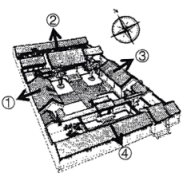
①Walking in the hutongs of Beijing, you’ll see a yard with the houses and walls on the four sides. It is called “Siheyuan”, a traditional building in China. “Si” means east, west, south and north and “he” shows the traditional values of Chinese families.
②The big gate was painted red, because red is the symbol of luck and happiness. Behind the gate, a large screen wall would stand. In the center of the Siheyuan, the courtyard was planted with trees and flowers, with two stony paths leading to the houses on each side.
③The whole building usually faces south, with a main room on the northern side, an opposite room in the south, and eastern and western wings (厢房) on each side. The old usually live in the main room which has good lighting and temperature all year round, while the young would live in other wings.
④Today, influenced by social changes, most houses have been taken down while the others that remain till these days are mostly improved to make them fit for today’s modern living. This makes Siheyuan a valuable memory of the old Beijing city.
⑤Luckily, architects (建筑师) have been trying to achieve a perfect mix of the modern and the traditional culture. For example, the place where athletes stayed during the 2022 Winter Olympics in Beijing were designed in the shape of Siheyuan.
⑥Siheyuan’s symmetry (对称的) design and shared spaces show the values deep in Chinese people’s hearts, such as belief in balance and the importance of family and respect for older people. No matter how society has changed, Siheyuan is always seen as a symbol of China’s rich culture. When you come to Beijing, do visit a Siheyuan to feel the heart of the Beijing’s culture!
1. In what column (栏目) can you read the passage in the newspaper?| A.Nature and animal. | B.Food and health. | C.Science and technology. | D.Travel and culture. |
| A.① | B.② | C.③ | D.④ |
| A.“Si” means four directions and “he” means wealth and happiness. |
| B.The big gate of Siheyuan is usually painted red, green and black. |
| C.Most of the Siheyuan aren’t kept well because of social changes. |
| D.Siheyuan shows the importance of family and care for the young. |
A.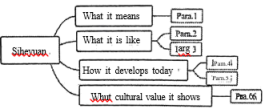 | B.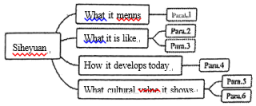 |
C.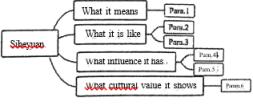 | D.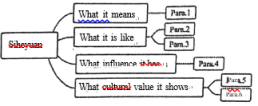 |
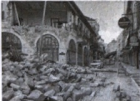
On an early Monday morning in February, 2023, a strong earthquake hit southern Türkiye and northern Syria. The earthquake destroyed (摧毁) thousands of buildings. Over 3,700 people lost their lives.
The earthquake, which happened in Türkiye near its border (边界) with Syria, was the strongest earthquake to hit Türkiye in over 80 years. It was strong enough to be felt in other countries. The earthquake had a magnitude (震级) of 7.8. Since then, the area has been hit by over 130 aftershocks (余震).
Thousands of rescue (救援) workers tried their best to find and save people in the earthquake. Türkiye said it sent out more than 9,600 rescue workers. Many countries have also sent teams of rescue workers to the area to help out. China’s rescue teams arrived in Türkiye on Wednesday. The leaders of over 40 different countries had offered help.
But rescue workers faced many difficulties. The earthquake and its aftershocks destroyed many roads. The government had to ask people to keep the roads clear for rescue workers.
The weather also caused some problems. Before the earthquake, the area was experiencing a heavy snowstorm. Snow and rain made rescue work more difficult.
In northwest Syria, things were even worse. At least four hospitals in the area were destroyed by the earthquake.
Many of the people there lived in tents (帐篷) or in special camps for people who lost their homes in the war. More than half of the 4.6 million (百万) people who lived in the area had trouble getting enough food.
1. How many people died in the earthquake?| A.Less than 3,000. | B.3,000. | C.More than 3,000. |
| A.Only people in Türkiye could feel the earthquake. |
| B.People in that area were shocked after that for 130 minutes. |
| C.Over the past 80 years, Türkiye hadn’t been in such a strong earthquake. |
| A.There were few rescue workers sent to Türkiye. |
| B.The broken roads and bad weather were also big problems. |
| C.There was no difficulty for people to get enough food and place to live. |
| A.In a novel. | B.On a newspaper. | C.In a history book. |
【推荐2】Good morning, everyone! It is 8 o’clock now. Here’s today’s city travel news.
Many people in London take the subway to work. But now they can’t take it. There is a big problem with the subway in London.
Right now, it is snowing heavily in Moscow. The streets are empty. People are not walking or driving to work. There aren’t any cars or buses on the streets.
There are no traffic (交通) problems in Rome and Tokyo now. There are a lot of people on the streets, but everyone will get to school or work on time.
The students in Madrid can’t take school buses this morning. The bus drivers in Madrid are on strike (罢工) today. Some students are walking to school. But many more students are staying at home.
That’s today’s city travel news. We wish you have a good day in your city.
1. In London, people can’t go to work by ______ now.| A.bike | B.subway | C.bus |
| A.拥挤的 | B.空荡的 | C.整洁的 |
| A.Tokyo and Madrid | B.Moscow and Madrid | C.Rome and Tokyo |
| A.the weather is terrible |
| B.the driver doesn’t work |
| C.there are some problems with the bus |
| A.traffic | B.children | C.history |
【推荐3】Teens will finally grow up some day, leaving their parents and facing the challenges in life alone, so they should learn basic life skills and form good working habits.
The government has been trying to pay attention to the importance of hardworking spirit education(劳动教育). But this has been overlooked in recent years. Many teens do not value the importance of working hard. There is a teenager girl named Nancy, she never helps out around the house. Once her mother was on vacation for a week, leaving her alone at home. When her mother came home from vacation, she could not find a clean dish or a clean shirt.
Schools play an important role in teaching students about the value of working hard. Primary and middle schools should provide students with hardworking spirit courses every week. To our joy, some schools have provided each class with a piece of field to plant their favorite vegetables. For example, No.38 Middle School in Hefei, set up a 500-square-meter farm on an open platform(露天平台) of their teaching building. Each class are asked to grow and pick vegetables there.
Parents should also encourage children to learn how to do chores at home. Teens should master one or two life skills every year. These skills can include cooking, washing their own clothes and tiding their rooms. The basic skills may help teens to solve the problems they will meet in the future.
1. What does the underlined word “overlooked” mean in Chinese?| A.强调 | B.忽视 | C.珍惜 |
| A.Nancy is too busy to help out around the house |
| B.Nancy’s parents don’t want her to help with chores at home |
| C.many teens do not value the importance of working hard |
| A.Playing computer games. | B.Washing clothes. | C.Cooking. |
| A.The government never pays attention to hardworking spirit education. |
| B.Parents should encourage their children to do chores at home. |
| C.Schools should teach students the value of working hard. |
| A.Family Education | B.School Education | C.Hardworking Spirit Education |
How’s it going? I am very happy these days, because during the days, there are many moon cakes. I love eating moon cake very much. There are many tastes(口味) such as sweet, salt and so on. I like the sweet ones especially the fruit-filled moon cakes. Do you want to know why there are so many moon cakes these days? It’s because the Middle-Autumn Festival is coming.
The Middle-Autumn Festival is one of the traditional Chinese festivals. It is often in September or October around the time of the autumn equinox(秋分). On Mid-autumn Festival, family members get together having moon cakes and enjoying the moon. The whole family usually share a round moon cake, that’s a symbol of the reunion(团圆). The custom(习俗) of eating moon cakes can date back (追溯) to the Tang Dynasty(朝). It became popular with the whole nation in the Ming and Qing Dynasties.
What’s your favorite festival? Can you tell me something about it?
Best wishes!
Zhang Jie
1. Zhang Jie feels ________ now.| A.afraid | B.enjoyable | C.bad | D.surprised |
| A.bean paste(酱) | B.egg-yolk | C.meat | D.strawberry |
| A.Just because they are delicious. |
| B.Because moon cakes are cheap. |
| C.Because moon cake is a symbol of reunion. |
| D.Because there are so many kinds of moon cakes on the festival. |
| A.There are only two tastes. |
| B.Moon cakes are only on sale on the Middle-Autumn Festival. |
| C.Eating moon cakes began from the Ming and Qing Dynasties. |
| D.Moon cake is a symbol of the reunion. |
| A.Zhang Jie’s favorite food |
| B.why Zhang Jie likes moon cakes |
| C.something about moon cakes |
| D.why Chinese like moon cakes |
【推荐2】Family is very important for everyone, no matter where you are from. So in both East and West, people have festivals to celebrate family reunions (团聚). These festivals include the Mid-Autumn Festival in China and Thanksgiving Day in the US. How are they celebrated and what are the differences? Let’s take a look.
Sharing the moonlight
The Mid-Autumn Festival is the second most important traditional festival in China after the Spring Festival. It’s on the 15th day of the eighth month of Chinese lunar calendar. In ancient China, the day was considered as a harvest festival since fruits, vegetables and grain (谷物) had been collected from the fields. All the family got together and had a big dinner. They ate a special festival food—mooncakes and enjoyed the full moon.
On that day, the moon is full. The full moon is a symbol for family reunions which means tuanyuan in Chinese. Now people also celebrate the festival by getting together and having a big dinner.
When it gets dark, people look up at the full moon, eating moon cakes and missing friends and relatives who are far from home. “We wish each other a long life so as to share the beauty of this graceful moonlight, even though miles apart!” wrote Su Shi, a famous Song Dynasty poet.
Showing thanks
Thanksgiving Day is one of the biggest holidays in the US. It’s on the fourth Thursday of November. People visit their friends and relatives to remind themselves that they are lucky to have happiness, health and family and also to have a roof over their heads.
In 1621, about 100 English people took a ship, the Mayflower, and arrived in the northeastern US. The winter there was very cold and life was hard. As the American Indians helped them a lot, the English people asked them to have a big meal with then in order to express their thanks. The celebration lasted for three days.
Today, people usually have a family meal on Thanksgiving Day. They enjoy delicious food such as pumpkin pie and a big, golden turkey.
There are other traditions on the day. For example, the turkey has a V-shaped bone in the breast. It’s called a wishbone. After roasting (烤), two persons each take one end of the bone. They make a wish and then pull it. If one gets the larger part of the bone, he or she will get good luck.
The most important part of Thanksgiving Day is to say “thanks”—this is the spirit of the holiday. People also like to watch the Thanksgiving Day Parade on TV.
1. Why did people celebrate the Mid-Autumn Festival in ancient China?| A.Because people could eat moon cakes. |
| B.Because people enjoyed the full moon. |
| C.Because people could get together with relatives. |
| D.Because people had a good harvest from the fields. |
| A.但愿人长久,千里共婵娟 | B.锄禾日当午,汗滴禾下土 |
| C.床前明月光,疑似地上霜 | D.海上生明月,天涯共此时 |
| A.The traditional food of the two festivals. | B.The introduction to the two festivals. |
| C.The activities of the two festivals. | D.The customs of the two festivals. |
【推荐3】Hi, everyone! Happy the Year of the Dragon (龙)!
I’m Lin Lin, a student from a middle school. I live in a village (村庄) with my family. Before the Year of the Dragon, we need to buy some things for the family, so my parents and I go to the city. We go to some stores and buy many things. Look! This is my jacket. It’s $22. The pair of shoes is mine, too. They’re only $15. That’s a sweater for my mother. How much is it? Oh, it’s $28. My father’s trousers are nice and they are $30. We buy my brother Lin Yue a new jacket and a model plane.
In 2024, I want to be healthy. I need to study hard and get good grades. Hope you can have a good time in the new year!
1. There are ________ people in Lin Lin’s family.| A.two | B.three | C.four | D.five |
| A.$15. | B.$22. | C.$30. | D.$37. |
| A.想法 | B.成绩 | C.朋友 | D.号码 |



